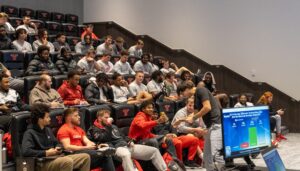Financial literacy programming, while important, has often been found to have a limited impact on actual financial behavioral change. It’s time to redefine the success metrics college personal finance programs use. To truly assess the success of a college personal finance program, you must aim beyond information retention and focus on tangible improvements in students’ financial well-being. This article delves into the critical importance of setting meaningful success metrics for personal finance programs and outlines key factors to consider when measuring the program’s impact.
Moving Beyond Box-Ticking
It’s easy to fall into the trap of viewing success in a personal finance program as students being able to recite financial definitions or concepts.
However, the ultimate goal is for students to translate their knowledge into real-world actions that lead to improved financial health. The question is:
Do you want your program to merely check a box or do you wish to empower your students to be in a better financial position?
Measuring Meaningful Financial Behaviors
To genuinely gauge the success of a personal finance program, it’s essential to focus on metrics that reflect actual financial behaviors.
These metrics provide insights into whether students are applying their learning to make positive financial decisions. Here are some crucial metrics that should be considered:
-
- Spending Within Means: Determine if students are effectively managing their expenses relative to their income. Are they living within their financial means and avoiding overspending?
-
- Debt Management: Evaluate whether students are accumulating excessive debt or managing their existing debt responsibly. This metric reflects their ability to control borrowing and make informed decisions about credit.
-
- Financial Accounts: Examine the types of financial accounts students have. Accounts to check are savings accounts, emergency funds, credit cards, brokerage accounts, IRAs, and Roth IRAs. Do they have the right tools in their toolbox to be financially successful?
-
- Credit Score Awareness: Assess whether students are aware of their credit scores and understand their significance. This metric reflects their awareness of their financial standing and ability to monitor their credit health.
Implementing Measurement for Success
To effectively measure the success of a personal finance program, it’s crucial to establish a baseline of students’ financial situations at the program’s outset and track their progress over time. The following steps can aid in implementing a robust measurement strategy:
-
- Baseline Assessment: Understand the financial status of students before the program begins. This includes gathering information on their spending habits, debt levels, existing accounts, and credit scores.
-
- Tracking Progression: Utilize tools like the Ostrich financial health score, which provides a baseline snapshot of students’ financial well-being. Regularly track this score to observe changes and improvements over time.
-
- Customized Approach: Acknowledge that each student enters the program with a unique financial background. Tailor guidance to address individual needs, recognizing that progress will vary.
What’s most important is not total dollar values as most students are not near their full-time earning potential or may not have any income at all. Showing students the steps they can take to set themselves up for success and the small behaviors that overtime will lead to big financial outcomes is the key.
Conclusion
Redefining success metrics for a college personal finance program involves shifting the focus from theoretical knowledge to practical financial behaviors.
By assessing metrics that make up an individuals financial health, educational institutions can accurately gauge the impact of their programs.
While in school, most students will not be earning a full-time salary commiserate with their long-term earning potential. This means that measuring actions are more important than dollar values.
Implementing a systematic measurement strategy that considers each student’s starting point and tracks their progress empowers universities to make informed improvements and provide meaningful financial education.
Ostrich has shared a full guide on how universities can create impactful personal finance programming. Additionally, Ostrich offers turnkey solutions for universities who are looking for more robust financial wellness programming.












